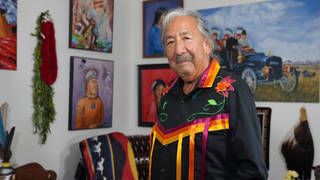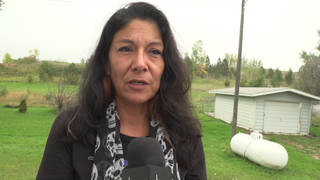
Salon.com published even more torture photographs from Abu Ghraib a day after the Australian report aired on SBS public broadcasting. The online publication obtained photos, video and other electronic documents from an internal Army investigation. We speak with salon.com reporter Mark Benjamin, who obtained the files and other electronic documents. [includes rush transcript]
The article accompanying the photos stated that the source who gave the material to Salon is “someone who has spent time at Abu Ghraib, is a uniformed member of the military and is familiar with the investigation.” The article goes on to say that the material includes “a total of 1,325 images of suspected detainee abuse, 93 video files of suspected detainee abuse, 660 images of adult pornography, 546 images of suspected dead Iraqi detainees, 29 images of soldiers in simulated sexual acts, 20 images of a solider with a Swastika drawn between his eyes, 37 images of military working dogs being used in abuse of detainees and 125 images of questionable acts.”
- Mark Benjamin, National Correspondent for online magazine Salon.com. He obtained files and other electronic documents from an internal Army investigation into the Abu Ghraib prisoner-abuse scandal. The material includes more than 1,000 photographs, videos and supporting documents from the Army’s probe.
Transcript
AMY GOODMAN: Well, I also want to bring in, Olivia Roussert, another reporter who is adding more photographs now in this country. On Thursday, a day after your report, the Australian report aired, Salon.com published more torture photographs from Abu Ghraib. The online publication obtained photos, video and other electronic documents from an internal Army investigation. The article accompanying the photos stated the source who gave the materials to Salon is, quote, “someone who spent time at Abu Ghraib as a uniformed member of the military and is familiar with the investigation.” The article goes on to say the material includes, quote, “a total of 1,325 images of suspected detainee abuse, 93 video files of suspected detainee abuse, 660 images of adult pornography, 546 images of suspected dead Iraqi detainees, 29 images of soldiers in simulated sexual acts, 20 images of a soldier with a Swastika drawn between his eyes, 37 images of military working dogs being used in abuse of detainees, and 125 images of questionable acts.” Mark Benjamin joins us in the studio now, the reporter who obtained these photos for Salon.com. As we speak with Olivia Roussert, Mark Benjamin, talk about what you have released.
MARK BENJAMIN: Well, what we have tried to do at Salon is to release images that no one has seen, in addition to the Australian television production, so we believe the images that ran with our article have not been seen by anyone and also depict images of abuse that no one has seen before.
AMY GOODMAN: Are these pictures overlapping with what Olivia Roussert has released on Dateline?
MARK BENJAMIN: I believe that what Salon has in our possession is what has been published by every news organization so far, including the Australian television production, and then some additional photos. In other words, it looks like our files, which come from an internal Army investigation, sort of have the full Monty, so to speak.
AMY GOODMAN: And explain one more time this internal Army investigation. Who conducted it?
MARK BENJAMIN: The Army’s Criminal Investigation Command — it’s sort of their internal investigation unit — conducted a look at the photos, specifically, and the people in the photos. A lot of the materials are from the summer of 2004, when the story broke. It’s called C.I.D. The Army C.I.D. unit is looking at those photos. The investigation shows them developing a timeline, looking at the stamps on the photos, the electronic stamps on the photos to figure out when they were taken, to try to identify the detainees who were being abused and identify the specific soldiers who were carrying out the abuse.
I would note, while there have been some broader Army investigations, which have been controversial, to look at the chain of command, this investigation does not look at the chain of command at all. It appears to be solely focused at who those soldiers are that are in the pictures, carrying out the abuse.
AMY GOODMAN: We have to break and when we come back, we’ll continue with Mark Benjamin of Salon.com and Olivia Roussert of SBS Dateline in Australia.
[break]
AMY GOODMAN: As we talk to Olivia Roussert of SBS Dateline in Australia and Mark Benjamin, a reporter who has been covering soldiers in Iraq and back from Iraq, especially many of the wounded, the tens of thousands. Mark Benjamin works for Salon.com. I want to ask you the same question I asked Olivia, Mark, and that is, your response to the U.S. government, the State Department condemning the release of these photographs.
MARK BENJAMIN: I would just add that that argument has already been rejected by a federal judge who said, you know, release the photographs doesn’t — if it — essentially, terrorists need no pretext to carry out their terrorist acts, so I think that argument has been rejected. And I agree that, you know, if the Army is so concerned about images of torture or abuse inciting violence, one thing to do is to try to prevent it in the first place.
I would also note that this — one of the reasons why we’re conducting this investigation at Salon is because there are some indications that would suggest that the responsibility for this abuse may go relatively high in the chain of command. For example, the military intelligence folks who are the professional interrogators are heavily involved in directing operations at Abu Ghraib, according to the materials that we have. The materials also show heavy involvement by O.G.A., Other Government Agency, which is a code word for C.I.A. folks. The involvement of those people at the prison suggests the possibility that this was a more organized abuse situation, and until we’ve gotten to the bottom of that, we’re going to continue to investigate, and if in the process of that we come across photos that we believe should be part of the public record, we are going to publish them.
AMY GOODMAN: Olivia Roussert, images of C.I.A. involvement?
OLIVIA ROUSSERT: Look, from what I’ve — I think Salon have had more printed material that sort of describe the photos more. What I’ve got, I think, is the same photographs without the backup. There seems to be, and I think it’s pretty clear. It’s a bit more guarded in the U.S., it seems, when people talk about this, but it seems to me to be a bit of a given here, anyway, in people’s knowledge of what happened there, that absolutely M.P.s were under military intelligence command and orders and that C.I.A. were involved, for instance, in the death of Manadel al-Jamadi, the corpse that appeared in the first leaked photographs and now in further ones. He died under C.I.A. interrogation.
AMY GOODMAN: Yes, that’s the image I was referring to before.
OLIVIA ROUSSERT: Yeah, oh, okay. Yeah, I don’t — he wasn’t a general, though. But he — you know, it’s, I think all of that’s pretty clear. And it’s good that this stuff comes out, because anything else, it sort of forces people to actually acknowledge that, instead of somehow not stating the obvious truth, I don’t know.
AMY GOODMAN: Olivia, the response in Australia, which was the Australian government supporting Bush in the invasion?
OLIVIA ROUSSERT: Sorry, Amy?
AMY GOODMAN: The response in Australia to these images, the government supporting President Bush and the invasion?
OLIVIA ROUSSERT: Look, the response here has been interesting. It’s sort of, you know, like most places in the world. There were great marches, and the people were mainly against the invasion of Iraq, but we went, and opinion sort of shifted both ways. It’s interesting here, people have been a lot quieter about the release of these photographs, as far as I can tell, anyway. Obviously, it plays out a lot more in the U.S., but I think there’s a lot of fear that people have about this, about — a lot of people have been talking about the cartoons, and I can’t see the parallel at all. But they’re making a link.
AMY GOODMAN: Finally, Mark Benjamin, the person you got this cache of photos and videos from, how close to the investigation, and because you work with soldiers so much, the response of U.S. military soldiers?
MARK BENJAMIN: Well, I’m not going to talk at all about the source who gave me the materials from the Army. I do also, separately, I do know some lower level soldiers who served at Abu Ghraib, and I would say that they are — I would say some of them are furious, because they believe very strongly that the abuses there, and some of this has come out in trials of the lower level enlisted folks who have been put in prison over this. They believe very strongly that the abuses that occurred at Abu Ghraib were a result of the actions of the higher echelons in the Army, in other words, the Army brass and perhaps higher, and they are furious and angry, because they believe that those higher-ups, who should bear some responsibility, have not been brought to justice.
AMY GOODMAN: How high up?
MARK BENJAMIN: They don’t know. I mean, in other words, what they know is that military intelligence was telling — appears to have been telling them what to do, or they say they were. They know that the C.I.A. was there running the show in some cases, and there are also some soldiers who have said publicly that when they tried to tell very high level people what was going on, they were told to shut up. And that has made some of those soldiers very, very angry, and it has increased their belief that was going on here goes high. I think that’s one of the reasons why we’re working so hard on this story. We’re trying to figure out just how high it goes.
AMY GOODMAN: I want to thank you, Mark Benjamin of Salon.com, and Olivia Roussert of SBS Dateline, for joining us. And again, Link TV, which is on DirecTV, Channel 375, on Dish Network, Channel 9410, will have the exclusive broadcast of the whole SBS Dateline report tonight at 7:00 Eastern, 4:00 Pacific Standard Time, the network that Democracy Now! also broadcasts on.












Media Options